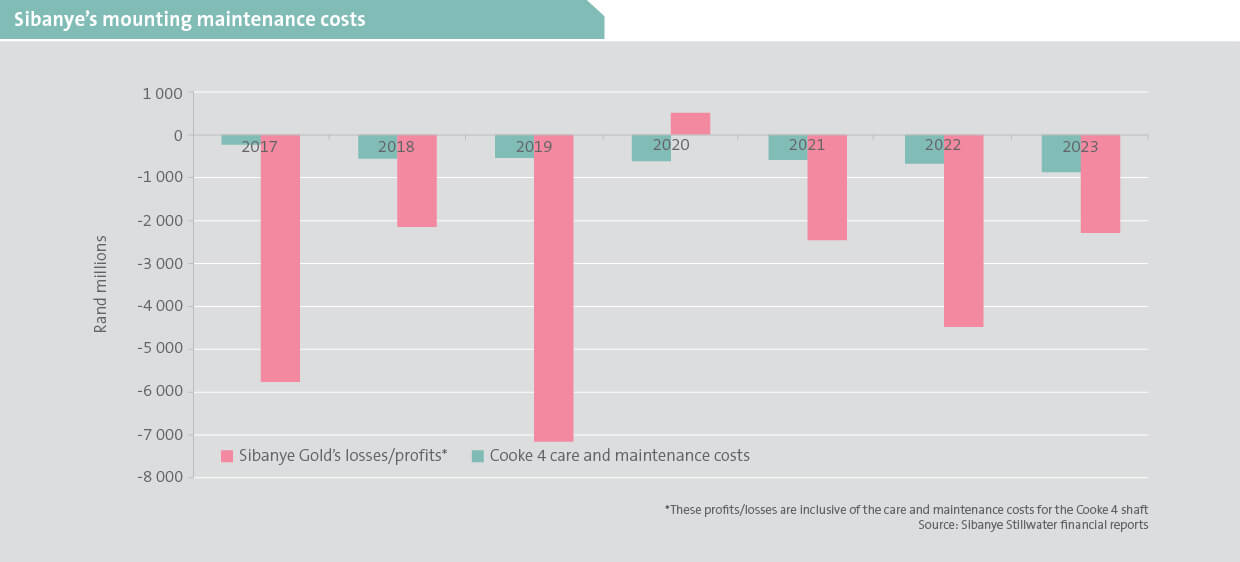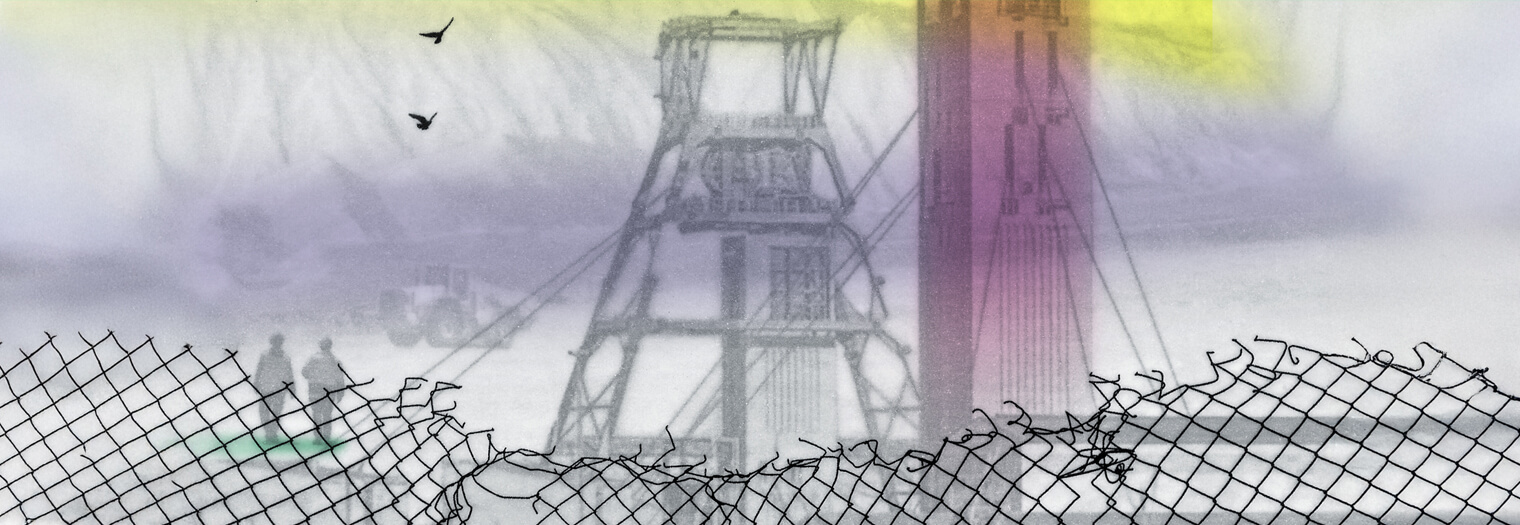Water in the way of gold
Since gold was first extracted in 1886, the Witwatersrand Basin has produced more than 30% of all the gold ever mined. The formation of this basin took place over 360 million years, with crustal plate movements from the north and west forming a basin-like setting. Roughly three billion years ago, violent storms smashed up gold bearing mountains and deposited boulders, sand, clay and gold into the basin. Over time, this basin was buried by eroded material, lava and dolomites forming the world’s largest gold deposit.
The western section of the basin retains a layer of dolomitic rock – a unique geological characteristic for a gold mineral deposit. Dolomite is unusual in that it absorbs enormous quantities of rainwater and then gradually dissolves, creating porous cavities and compartments that store vast amounts of underground water. The gold-bearing ore body lies underneath these dolomitic formations. Eventually, the water stored in the dolomite permeates the rock, flowing into the mining areas below. To access and extract the gold, mining companies must pump out the water using a complex method that adds significant costs to mining operations.
Pumping up costs
Extracting the underground water requires a complex underground system to channel the water to a central collection point, from where it is then pumped to the surface. Thereafter, the water is treated to remove contaminants and used as drinking water and for operational purposes, reducing the need for mining companies to draw on municipal water.
Water extraction costs for the surviving West Wits mines are between 5-10% of the total operational costs of the mines. Deeper mines face higher pumping costs than shallower ones, due to the higher energy requirements to pump from greater depths. As a result of the long mining history in this region and the depth of the gold deposits, these mines are the world’s deepest. For example, Mponeng mine, which extends five kilometres below the surface.
Calling for cautious mine closure
Once a mine reaches the end of its life, the relevant mining company must initiate a complex closure process involving decommissioning, rehabilitation and long-term monitoring.
South Africa’s National Environmental Management Act (NEMA) of 1998, holds mining companies responsible for the environmental impact of their extraction activities. NEMA mandates mining companies to establish financial provisions to cover the costs of closure, via the establishment of a rehabilitation fund, which is built up throughout the operating life of the respective mine. The size of the fund depends on the anticipated cost of environmental repair once a mine closes operations. This fund can only be accessed for the purposes of paying rehabilitation and other ongoing costs, once a closure certificate is issued. Thereafter, the mining company is absolved of any further environmental liabilities. The Department of Mineral Resources and Energy (DMRE) issues the certificate once it is satisfied that the law has been fully complied with, and it can confirm that there are no major remaining public objections. The department is, however, cautious about granting closure certificates prematurely, as any unresolved environmental issues would then become the government’s responsibility.
Environmental concerns include potential safety hazards for active neighbouring mines and the long-term risk of acid mine drainage (AMD1, which can contaminate important water sources, exacerbating ongoing water scarcity issues in Gauteng.
1AMD occurs when underground water comes into contact with acid and sulphur-bearing rocks that are unearthed during the mining process. This creates toxic water that flows to nearby river systems, posing health and environmental risks.
Last men standing
As mines in the Witwatersrand became deeper, mining costs rose and accessible deposits were depleted. Declining profitability caused many mines to close. A few major players have remained active, namely Sibanye Stillwater (Sibanye), Harmony Gold (Harmony) and Gold Fields. AngloGold no longer operates in the region, following the sale of its last South African mine (Mponeng) to Harmony Gold in 2020.
As illustrated below, the mining companies’ operations in West Wits are geologically interconnected. The only distinction lies in the legal ownership boundaries held by the different mining companies.
The challenges of water management in this region vary depending on the geological characteristics of each mining site. Most of Sibanye’s operations lie to the north and within the dolomite rock formation (including the Kloof, Cooke 4 and Driefontein mines), suggesting a far greater underground water issue for them. Sibanye’s Driefontein mine has 10 years’ life-of-mine remaining based on reserves, while Mponeng has 20 years. Sibanye is therefore likely to encounter difficulties in obtaining a closure certificate due to the flooding risks posed to neighbouring Mponeng, which will still be operational after Driefontein is closed.
While outside the dolomite zone, the Mponeng and Kusasalethu mines are vulnerable to flooding from the water-logged Blyvoor and Driefontein mines. When Harmony acquired Mponeng in 2020, it took on an additional liability to mitigate this risk by also acquiring a water management company, Covalent, to actively pump water from Blyvoor to safeguard Mponeng operations for the next 15 years. We believe that as these gold companies are faced with such water ingress issues, their liabilities do not fully provide for the full cost of care and maintenance post mine closure.

Zero closure as Sibanye battles Gold Fields
Sibanye has been embroiled in a legal dispute with the DMRE since 2016, to obtain a closure certificate for its Cooke 4/Ezulwini shaft, which was operational for 55 years. Located in the west of the Wits region, this mining shaft faces severe water ingress, requiring the extraction of over 20 million litres of water a day. Initially, Sibanye wanted to stop all pumping activities and allow the mine to fill with water. However, the active neighbouring South Deep mine (owned by Gold Fields, with an 85-year lifespan based on reserves) opposed the closure certificate. Gold Fields argued that the mines are separated only by a seal that could fail due to water pressure if water extraction stops. This would result in the flooding of the South Deep mine with massive economic damages and potential loss of lives.
In May 2023, the Supreme Court sided with Gold Fields, instructing Sibanye to continue with water extraction at their Cooke 4 shaft to ensure the safety of South Deep’s operations. Consequently, Sibanye faces mounting care and maintenance expenses, primarily attributed to water management. This includes the significant cost of electricity required for deep shaft water extraction, making it increasingly difficult for Sibanye to manage rising costs amid escalating electricity tariffs.
Furthermore, without a closure certificate, Sibanye cannot access their rehabilitation fund to help defray these mounting expenses. Since 2017, it has spent approximately R4 billion in care and maintenance costs for the inactive shaft. As charted below, the Cooke 4 mine no longer generates revenue, therefore costs are borne by other active (high-cost) gold operations. These have been operating at a loss over the past six years, with the care and maintenance costs contributing to the loss-making position, leading to significant cash flow strain.
Over the next eight years, more of Sibanye’s gold operations will face a similar fate to Cooke 4 as their West Wits operations come to an end. This will amount to a heavy financial liability, which will be added to Sibanye’s extremely strained balance sheet.

Financial, environmental and safety implications
The persistent and complex challenge of managing underground water in the Witwatersrand region carries substantial financial, environmental and safety implications. The Sibanye Stillwater case highlights the difficulties and costs associated with mine closure within this unique geological context. The interconnectedness of mining operations adds enormous complications with risks to neighbouring mines.
Given the apparent lack of public analysis and quantification of these material liabilities, we believe they are significantly underestimated in the market valuations of the companies with remaining gold mining operations in the West Wits region.





